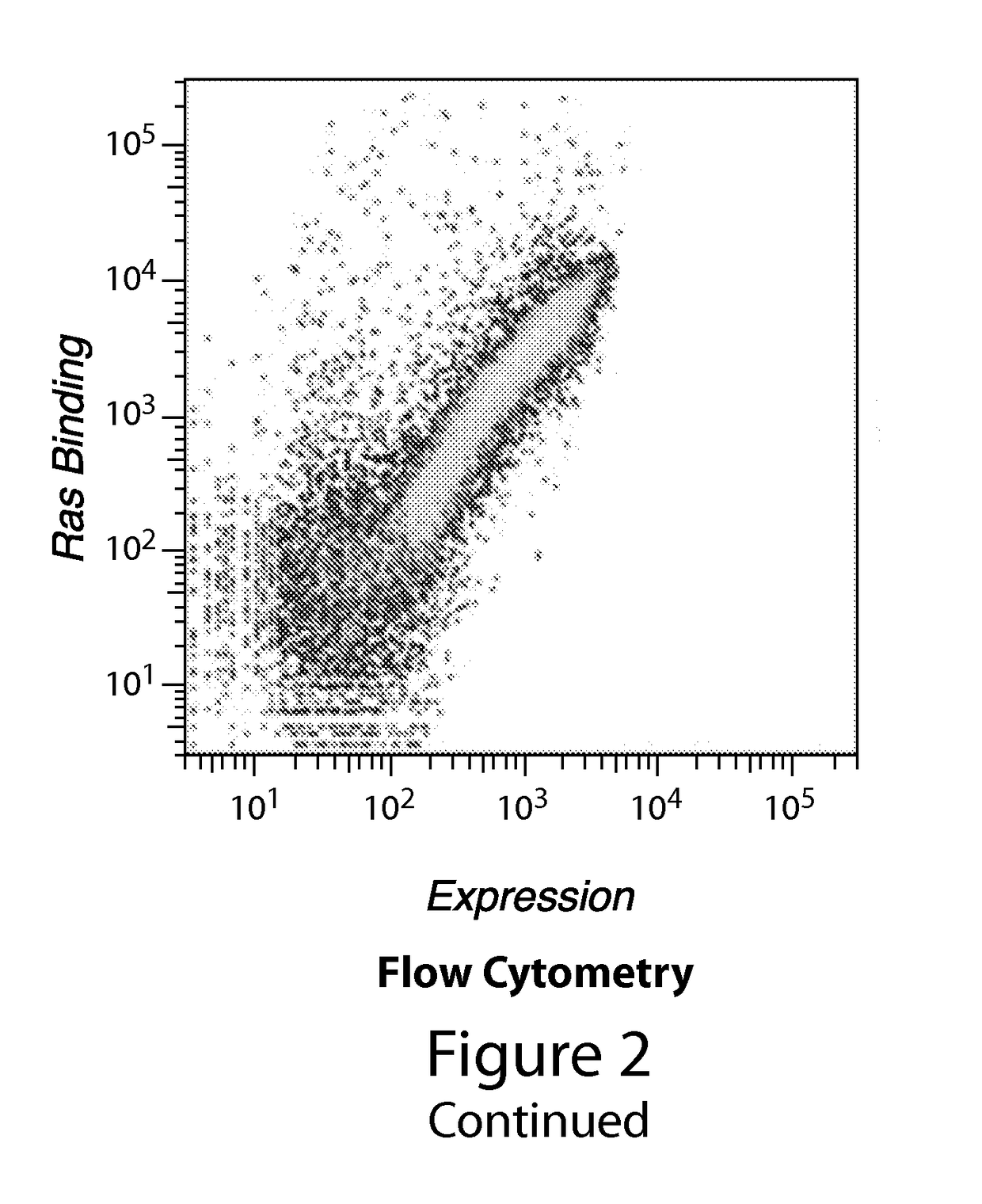Ras inhibitory peptides and uses thereof
a technology of inhibitory peptides and peptides, which is applied in the field of therapeutics, can solve the problems of often limited ability to exploit these discoveries for therapeutic benefits, and achieve the effects of reducing negative charges, increasing cell penetration, and increasing cell penetration
- Summary
- Abstract
- Description
- Claims
- Application Information
AI Technical Summary
Benefits of technology
Problems solved by technology
Method used
Image
Examples
example 1
Ras Binding Peptides Characterization and Ras-Petide Crystal Structure
[0351]Binding Affinity. Binding affinity of the peptides to K-Ras was determined by fluorescence polarization experiments. Below is the sequence of the peptides used along with their dissociation constants measured.
PeptidePeptide SequenceKdRDA1GPRRPRCPGDDASIEDLHEYWARLWNYLYAVA17 nMRDA2GPRRPRCPGDDASIEDLHEYWARLWNYLYRVA 8 nMRDA3GRRPRRPRCPGDDASIEDLHEYWARLWNYLYAVA 6 nM
[0352]Reduction Tests. This is an HPLC assay that can distinguish between oxidized (disulfide-crosslinked) peptide dimers from reduced (non-crosslinked) peptide monomers. By adding 5 mM or 50 mM DTT, a reducing agent much stronger than the cellular environment, it was observed that the selenocysteine-containing peptide dimers cannot be reduced, unlike their cysteine-containing analogs (see FIG. 31).
[0353]Ras-RDA structures. FIG. 32 shows the overall structure, at 2.2 Angstrom resolution. FIG. 32 also shows the primary helix and the key binding residues ide...
example 2
Yeast Display Screen for Ras-binding Peptides
[0354]We pursued two strategies to identify peptides that bind the Ras effector domain, both of which involved screening large peptide libraries by yeast surface display. Our first approach was to screen naïve libraries that were based on a small peptide scaffold with no known ability to bind Ras. These libraries were designed to contain as much structural diversity as possible, while remaining in a stable conformation. Our second approach was to screen a library based on the domain of a protein known to bind the Ras effector domain. In this case, the goal of the screen was to identify a stabilized mutant of the domain that was capable of binding Ras in the absence of the scaffolding provided by its parent protein.
[0355]Library Scaffold Selection. To identify candidate scaffolds for the naïve libraries, we searched the Protein Data Bank for polypeptides with a mass between 1000 and 5000 Da for which either an X-Ray or nuclear magnetic res...
example 3
In vitro Characterization of Ras-Binding Peptides
[0372]From the directed evolution efforts, we selected two aPP-derived peptides, 225-1 and 225-3, for further study. These peptides bound KRas at nanomolar concentrations in the yeast display system, competed with Ras for Raf binding, and were remarkably tolerant to the presence of blocking agents (DNA and serum). This example describes the recombinant production of these peptides in E. coli, characterization of their binding properties in vitro, and initial efforts towards defining their binding site on the Ras surface.
[0373]Expression and Purification of 225 Peptides. During the course of the directed evolution experiments, we prepared a small number of aPP peptides (mostly from the 223 and 224 series) using solid-phase peptide synthesis, as was done by Schepartz and co-workers for their studies (see Daniels, D. S. and Schepartz, A. Intrinsically cell-permeable miniature proteins based on a minimal cationic PPII motif. J Am Chem Soc...
PUM
 Login to View More
Login to View More Abstract
Description
Claims
Application Information
 Login to View More
Login to View More - R&D
- Intellectual Property
- Life Sciences
- Materials
- Tech Scout
- Unparalleled Data Quality
- Higher Quality Content
- 60% Fewer Hallucinations
Browse by: Latest US Patents, China's latest patents, Technical Efficacy Thesaurus, Application Domain, Technology Topic, Popular Technical Reports.
© 2025 PatSnap. All rights reserved.Legal|Privacy policy|Modern Slavery Act Transparency Statement|Sitemap|About US| Contact US: help@patsnap.com



